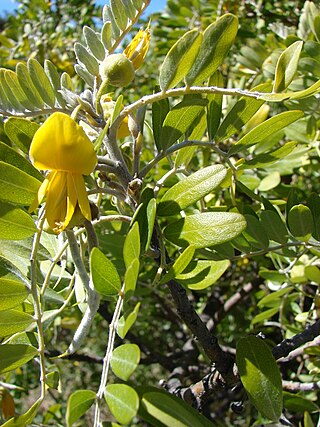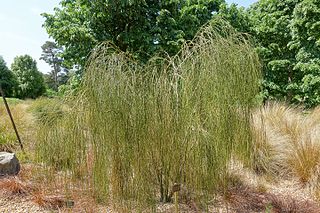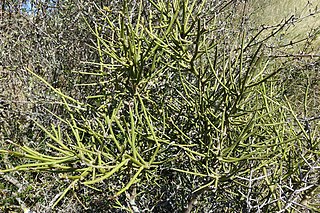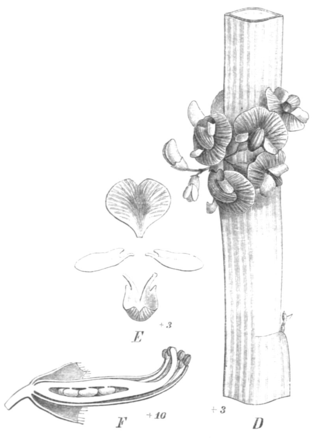
Sophora is a genus of about 45 species of small trees and shrubs in the pea family Fabaceae. The species have a pantropical distribution. The generic name is derived from sophera, an Arabic name for a pea-flowered tree.

Dermatophyllum/Sophora secundiflora is a genus of three or four species of shrubs and small trees in the family Fabaceae. The genus is native to southwestern North America from western Texas to New Mexico and Arizona in the United States, and south through Chihuahua, Coahuila, and Nuevo León in northern Mexico. Members of the genus are commonly known as mescalbean, mescal bean, or frijolito. One of the common names of Dermatophyllum secundiflorum is Texas mountain laurel, although the name mountain laurel also refers to the very dissimilar and unrelated genus Kalmia and the name laurel refers generally to plants in the unrelated order Laurales. Dermatophyllum secundiflorum is one of the most abundant woody species in the Texas Hill Country or Edwards Plateau.

Carmichaelia is a genus of 24 plant species belonging to Fabaceae, the legume family. All but one species are native to New Zealand; the exception, Carmichaelia exsul, is native to Lord Howe Island and presumably dispersed there from New Zealand.

Clianthus, commonly known as kakabeak, is a genus of flowering plants in the legume family Fabaceae, comprising two species of shrubs endemic to the North Island of New Zealand. They have striking clusters of red flowers which resemble the beak of the kākā, a New Zealand parrot. The plants are also known as parrot's beak, parrot's bill and lobster claw – all references to the distinctive flowers. There is also a variety with white to creamy coloured flowers called: "Albus," and a variety with rosy pink flowers called: "Roseus."

Clianthus puniceus, common name kaka beak, is a species of flowering plant in the genus Clianthus of the legume family Fabaceae, native to New Zealand's North Island.

Carmichaelia carmichaeliae is a species of plant in the family Fabaceae. It is found only in South Island of New Zealand. It is classified as having the "Nationally Critical" conservation status under the New Zealand Threat Classification System.

Carmichaelia glabrescens is a species of plant in the family Fabaceae. It was first described by Donald Petrie in 1921 and was formally known as Notospartium glabrescens.

Carmichaelia torulosa is a species of plant in the family Fabaceae. It is found only in New Zealand.

Galegeae is a tribe in the flowering plant family Fabaceae, subfamily Faboideae. The tribe is found mostly in the northern hemisphere, but can also be found in Australia, Africa, and South America. Recent molecular phylogenetic work has determined that tribe Galegeae is paraphyletic, and that its members are scattered throughout the IR-lacking clade.

Styphnolobium japonicum, the Japanese pagoda tree is a species of deciduous tree in the subfamily Faboideae of the pea family Fabaceae.

The Kopuatai Peat Dome is a large peatland complex on the Hauraki Plains in the North Island of New Zealand. It consists of two raised domes, one in the north and the other in the south, that are up to three metres higher at the center than at the edge. The 10,201 hectares wetland contains the largest intact raised bog in New Zealand and was listed under the Ramsar Convention in 1989 as a Wetland of International Importance. Most of the wetland is ombrotrophic, meaning it receives water and nutrient inputs solely from rain and is hydrologically isolated from the surrounding canals and rivers. Locally, a popular misconception persists that water flows from the nearby Piako River into the bog and that the wetland acts as a significant store for floodwater.

Aceria clianthi is a species of mite belonging to the family Eriophyidae. It is found only in New Zealand. It is notable for being host specific to threatened plants of the genus Clianthus. It is classified by Buckley et al. as "nationally critical" under the New Zealand Threat Classification System. They stated "Aceria clianthi (Eriophyidae), has been recorded only from kakabeak in cultivation and once on Lotus cornalatus [Lotus corniculatus] (Fabaceae), an introduced plant growing near kakabeak. It is given the same threat classification as kakabeak ." Heenan had earlier stated that "the two species [of Clianthus] are considered to be threatened, with C. maximus having a rank of vulnerable, whereas C. puniceus is critically endangered", but the conservation status of C. maximus was subsequently found to be more serious. These threat classifications for Clianthus apply to plants in the wild, but the species are widely cultivated. Aceria clianthi occurs on both plants in the wild and in cultivation.

Carmichaelia stevensonii, the cord broom or weeping broom, is a species of plant in the family Fabaceae. It is found only in the north east of the South Island of New Zealand. It is threatened by habitat loss.

Carmichaelia muritai, common name coastal tree broom, is a species of plant in the family Fabaceae. It is found only in the South Island of New Zealand.

Montigena is a genus of flowering plant in the legume family Fabaceae. It includes the sole species Montigena novae-zelandiae, known more commonly the scree pea, a dicotyledonous herb endemic to the South Island of New Zealand. The plant is small and woody, arising from thin, branched stems that extend to the surface from a deeply buried root stock. The flowers vary from purple to brown, while fruits appear between January and April.

Carmichaelia petriei is a species of New Zealand broom in the genus Carmichaelia. It is endemic to New Zealand. C. petrieis is possibly a host plant for the critically endangered fungus weevil Cerius otagensis.
Peter Brian Heenan is a New Zealand botanist.

Carmichaelia curta is a species of plant in the family Fabaceae. It is found in New Zealand. It is classified as having the "Nationally Critical" conservation status under the New Zealand Threat Classification System.

Carmichaelia australis, commonly known as the New Zealand common broom or mākaka, is a shrub of the Fabaceae family. It is native to New Zealand and found in both the North and South Islands.

Festuca luciarum is a species of grass in the family Poaceae. It is endemic to New Zealand, found in the eastern North Island at higher altitudes.



















